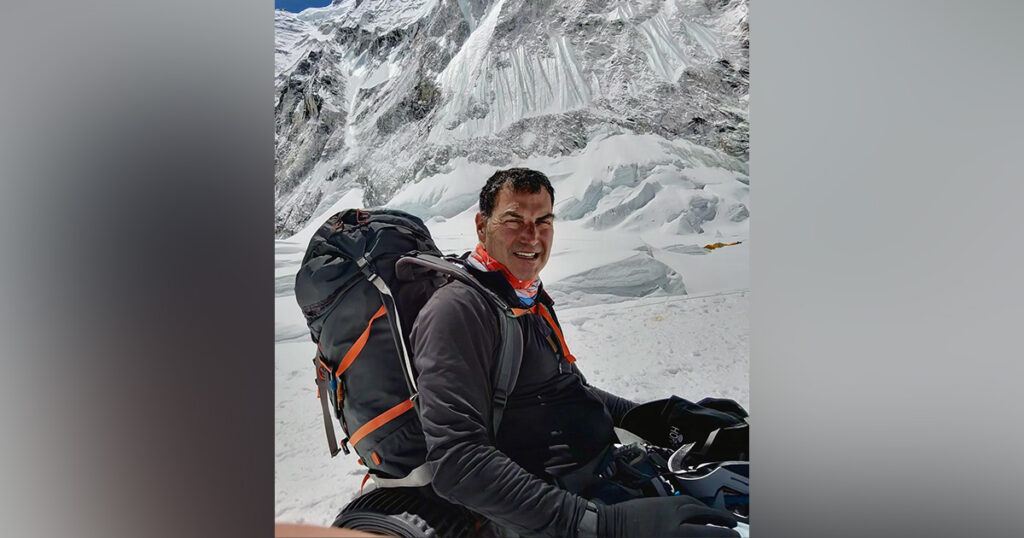When he stood atop Mount Everest—about 29,000 feet above sea level—earlier this year, Ball State University graduate Len Forkas, ’82, wasn’t thinking about personal glory; he was thinking about children. On his mind and in his heart were children battling cancer and facing one of the most difficult parts of treatment: isolation.
“One of the first things that happens when a child is diagnosed with cancer is social isolation,” Len said. “They leave school for treatment, lose contact with friends, and start to feel forgotten.”
Over the past 20 years, Hopecam, the nonprofit Len founded, has connected more than 5,500 children with over 95,000 classmates in all 50 states via webcam technology. Hopecam provides tablets, internet access, and tech support, working directly with schools and hospitals to ensure that children battling serious illnesses stay socially and emotionally connected. Len started Hopecam in 2003 after his son, Matt, was diagnosed with leukemia at age nine.
An entrepreneur, author, public speaker, and philanthropist, Len summited Mount Everest in May 2025 to raise awareness and support for Hopecam. It was the culmination of months of intense preparation, a display of resilience after a failed first attempt, and an emotional tribute to the kids whose names he carried to the top of the world.
“I wanted to share with the world the bravery and resilience of the children that Hopecam supported. They motivated me every day,” he said.
On his Everest mission, Len raised more than $860,000 for Hopecam and unfurled a flag honoring all the children whose lives the nonprofit has touched.
A Climb Fueled by Purpose
Len’s six-week Mount Everest expedition was full of challenges and unexpected turns. In 2023, he attempted the climb but had to turn back due to life-threatening pulmonary edema caused by the extreme altitude. It was a crushing setback.
Instead of walking away, Len reassessed and vowed to try again.
“My big lesson is that failure is a great teacher,” he said. “We rarely look closely at why we succeed, but when we fail, and fail big, we look at every ‘trip wire’ we crossed, we learn and come back smarter, stronger, and more deliberate.”
To get back to the mountain, he trained daily for a year, working with a coach, spending time in the gym, practicing climbs with heavy gloves, and spending hundreds of hours acclimating his body to harsh summit conditions. He even slept 400 hours over a six-week period before departing for Nepal in a “Hypoxic tent” to simulate higher altitude.
Len is no stranger to extreme endurance. After Matt’s diagnosis, he discovered endurance sports to help cope with the stress of his son’s illness, and channeled it into fundraising for Hopecam—completing 100-mile runs, Ironman triathlons, solo cross-country cycling races (he races 3,000 miles in 11 days), and even skiing to the South Pole.
His second Everest attempt succeeded, but not without peril. On the summit push, his satellite locator lost power from the -20 temperatures, leaving him untrackable for nearly 36 hours. On the descent after reaching the summit, he ran out of oxygen while descending a narrow ridge and fell into a crevasse. His guide pulled him out and provided a fresh oxygen tank. After 22 hours, Len returned to camp after reaching the summit. After a year of climbing specific training that prepared him for the expedition, he returned to Kathmandu dehydrated—nearly to the point of kidney failure—down 23 pounds and suffering from bronchitis.
Ball State as a Launchpad
Long before his Everest expedition or founding Hopecam, Len received his undergraduate degree in Landscape Architecture at Ball State. He credits his time in the Estopinal College of Architecture and Planning with instilling values that continue to guide him today.
“I was not accepted into the architecture program on my first try,” he said. “So, I had to work hard, get the grades, and apply again. That rejection taught me resilience—and that failure can be a powerful motivator.”
Teamwork and problem-solving were also major takeaways from his campus experience.
Len continues to give back to Ball State, including helping launch the John Russell Fund—named for an admired professor—to support student travel and enrichment in the Department of Landscape Architecture.
Len is also a sought-after leadership speaker who shares lessons from endurance experiences and how mission-driven teams are forged from resilience, empathy, and embracing the power of discomfort.
“Growth only happens when you’re uncomfortable,” he said. “If you’re always safe and comfortable, you’re not pushing yourself, and you’re not growing.”
His advice to Ball State students: be fearless.
“Take the class you’re unsure about,” Len said. “Apply for the internship that intimidates you. Dream big. Your Everest doesn’t have to be a mountain. It might be writing a book, starting a business, or making a difference in your community. Whatever it is, go after it—and don’t be afraid to fail.”
What’s Next
Having completed the Seven Summits—the highest peaks on each of the seven continents—including one climb with his now 32-year-old son, Matt. Len is part of an elite group of mountaineers. At 65, he is the fifth-oldest person to complete the challenge.
Next on his list: the North Pole. If he completes that journey next year, he will join fewer than 100 people in history to accomplish the Explorer’s Grand Slam—climbing the tallest peaks on all seven continents and skiing more than 60 miles to the South and North Poles.
But for now, he’s slowing down, focusing on time with his family, his work team, and the many people who supported him along the way.

